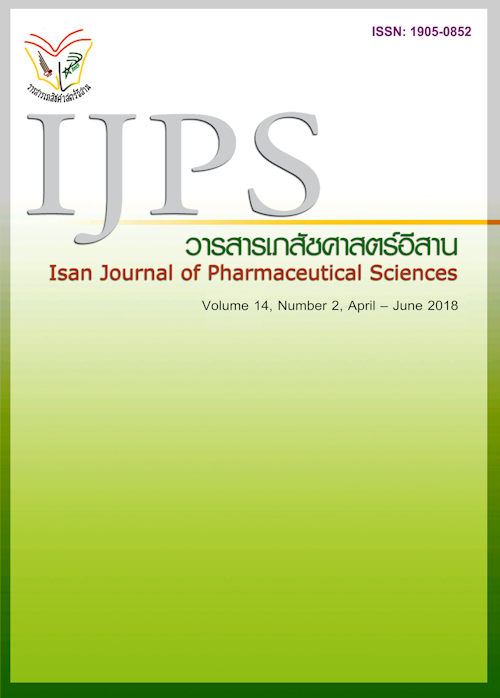Simple Method for Determination of Sodium Using Photogrammetry
Main Article Content
Abstract
The main purpose of this work is to study the possibility of using the digital image from digital camera and read RGB value by RGB reader program for determination of sodium in sport drinks sample. The present method is provides a simple, inexpensive instrumentation and rapid method. Materials and methods: The propose method was based on aspirated the standard or sample solution into burner which was ignited the flame by mixing fuel between air-acetylene gas. Digital image of fame emission was recorded using digital camera. The pictures of the flame emission from standard sodium solution and sport drinks sample were processed to read the RGB value using in-house GetPixel program. The RGB reader method was applied to quantification sodium from sport drinks sample and the results was compared to the flame atomic emission spectrophotometric method. Results: The calibration curve for standard sodium solution shown an excellent linearity over a concentrations range of 0.4 - 2.0 µg mL-1. Over the above concentrations range, liner regression of the RGB values (y) and concentration of sodium (x) expressed the equation y = 2.9031x + 0.9313. The correlation coefficients (r²) was shown to be 0.9901 (n=5). The limit of detection(LOD) and the limit of quantitation(LOQ) were determined for sodium, based on the criteria that the signal-to-noise ratio for LOD and LOQ are 3:1 and 10:1, respectively, for sample to blank. The results of LOD and LOQ were found to be 0.12 and 0.38 µg mL-1, respectively. Effect of some possible flavor sugars (glucose, dextrose and sucrose) and interfering ions (K+, Zn2+and Mg2+) on the determination of sodium were investigated using the developed method. All of flavor sugars and metal ions caused interference <±2.5 %. Conclusion: A simple method for determination of sodium in sport drinks was developed. The proposed simple RGB reader method and flame atomic emission spectrophotometric method showed positive agreement with no statistical difference at 95% confidence level. The study in this work has demonstrated the potential for RGB reader technique which were shown the simple procedure and cost-effective method.
Article Details
In the case that some parts are used by others The author must Confirm that obtaining permission to use some of the original authors. And must attach evidence That the permission has been included
References
Abramova N, Ipatov A, Levichev S, Bratov A. Integrated multi-sensor chip with photocured polymer membranes containing copolymerized plasticizer for direct pH, potassium, sodium and chloride ions determination in blood serum. Talanta 2009; 79: 984-989.
Buranakitjaroen P, Phoojaroenchanachai M. The prevalence of High sodium intake among hypertensive patients at hypertension clinic, Siriraj hospital. J. Med. Assoc. Thai., 2013; 96 Suppl 2: S1-S7.
Caland LB, Silveira ELC, Tubino M. Determination of sodium, potassium, calcium and magnesium cations in biodiesel by ion chromatography. Anal. Chim. Acta 2012; 718: 116-120.
Campbell N, Correa-Rotter R, Neal B, Cappuccio FP. New evidence relating to the health impact of reducing salt intake. Nutr. Metab Cardiovasc. Dis. 2011; 21: 617-619.
Havas S, Dickinson B, Wilson M. The urgent need to reduce sodium consumption. JAMA. 2016; 298: 1439-1441.
Hwang J, Kim JC, Moon H, Yang JY, Kim MK. Determination of sodium contents in traditional fermented food in Korea. J. Food Compos. Anal. 2017; 56: 110-114.
Kubán P, Greguš M, Pokojová E, Skricková J, Foret F. Double opposite end injection capillary electrophoresis with contactless conductometric detection for simultaneous determination of chloride, sodium and potassium in cystic fibrosis diagnosis. J. Chromatogr. A. 2014; 1358: 293-298.
Lopez-Molinero A, Cubero VT, Irigoyen RD, Piazuelo DS, Feasibility of digital image colorimetry-Application for water calcium hardness determination. Talanta 2013; 103: 236-244.
Lopez-Molinero A, Liñan D, Sipiera D, Falcon R. Chemometric interpretation of digital image colorimetry. Application for titanium determination in plastics. Microchem. J. 2010; 96: 380-385.
Pavadhgul P, Sunthonwaraluk S, Srisorachatr S, Temcharoen P. Dietary sodium intake by semi-quantitative food frequency questionnaire amoung undergraduate students of Mahidol University. J. Med. Assoc. Thai., 2009; 92 Suppl 7: S75-S81.
Song HJ, Cho YG, Lee HJ. Dietary sodium intake and prevalence of overweight in adults. Metab. Clin. Exp. 2013; 62: 703-708.
Suzuki Y, Endo M, Jin J, Iwase K, Iwatsuki M. Tristimulus colorimetry using s digital still camera and its application to determination of iron and residual chlorine in water sample. Anal. Sci. 2006; 22: 411-414.
Svensson S, Isacsson AC, Ljungkvist G, Torén K, Olin AC. Optimization and validation of an ion chromatographic method for the simultaneous determination of sodium, ammonium and potassium in exhaled breath condensate. J. Chromatogr. B. 2005; 814: 173-177.
Taylor RP, James T, Enzymatic determination of sodium and chloride in sweat. Clin. Biochem. 1996; 29: 33-37.
WHO, Guideline: Sodium intake for adults and Children. World Health Organization (WHO), Geneva; 2012.
Xu M, Zhou N. Image positioning accuracy analysis for super low altitude remote sensing satellites. Int. J. Adv. Robotic Sy. 2012; 9: 1-7.


